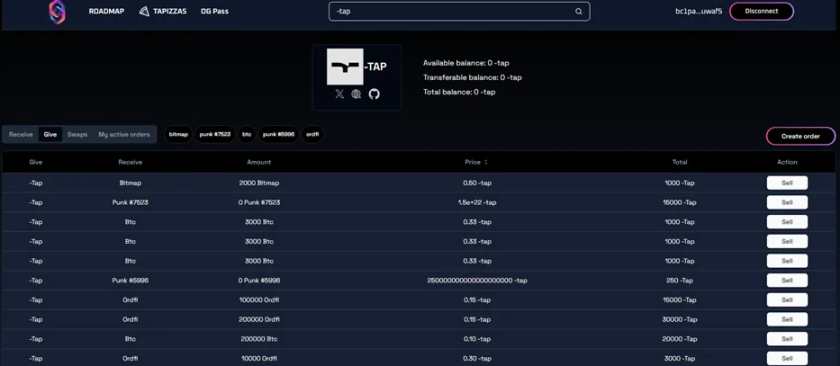Original Author: Jonnyhimalaya
Translated Title: Plain Blockchain
This article explores some of the most promising Layer1 Bitcoin decentralized exchange (Dexs) and automated market makers (AMMs). Most of these markets are still under development, and some are only in the testnet stage. Overall, these markets can be divided into two categories: order book trading platforms and automated market makers. This article has conducted research interviews with most of the teams involved.
DeFi on Bitcoin is coming soon. We have already seen the appearance of DeFi on Bitcoin, such as Ordinals, Runes, BRC20, and TAP, among other emerging protocols. The community hopes to trade "junk coins" on Bitcoin, but this situation is about to change!
Currently, the experience of trading tokens on Bitcoin is poor and full of friction. On markets like Unisat and Magic Eden, sellers of tokens (BRC20 or Runes) must list a specific quantity of tokens at a specific price and wait for buyers to purchase the same quantity of tokens at the same price, which increases the friction of the transaction.
Many teams are trying to solve this problem by introducing AMM and Dex-style trading to Bitcoin, providing a trading experience familiar to us on the EVM. Due to Bitcoin's use of the UTXO model, rather than the account model used by EVM, certain features need to be redesigned. In fact, UTXO has technical characteristics that EVM cannot achieve in designing partially signed Bitcoin transactions (PSBT) to achieve atomic swaps.
When analyzing each market, specific criteria were considered: user experience during exchange, degree of decentralization, permission allowance, and other trade-offs.
Most teams are innovating in the areas of PSBT and signature hash (Sighash). Signature hash is a mechanism used to sign inputs and outputs of Bitcoin transactions. There are six different types of signature hash, ranging from the most secure but least flexible "Sighash All" to the least secure but most flexible "Sighash None - Anyone Can Pay". Popular markets like Unisat and Magic Eden currently use "Sighash-Single" to create their PSBT. This means that not all outputs are signed, and transactions may be vulnerable to MEV sniping. Using "Sighash-All" means that all inputs and outputs are fully signed, and any transaction signed in this way can avoid MEV sniping.
When analyzing Dex or Swap, many other factors need to be considered, such as liquidity and slippage, market-making and taker fees, liquidity provider incentives, trading volume, and so on. However, since most of the analyzed markets are still in the testing or early release stage, these metrics will take time to become relevant.
1. Fluid BTC
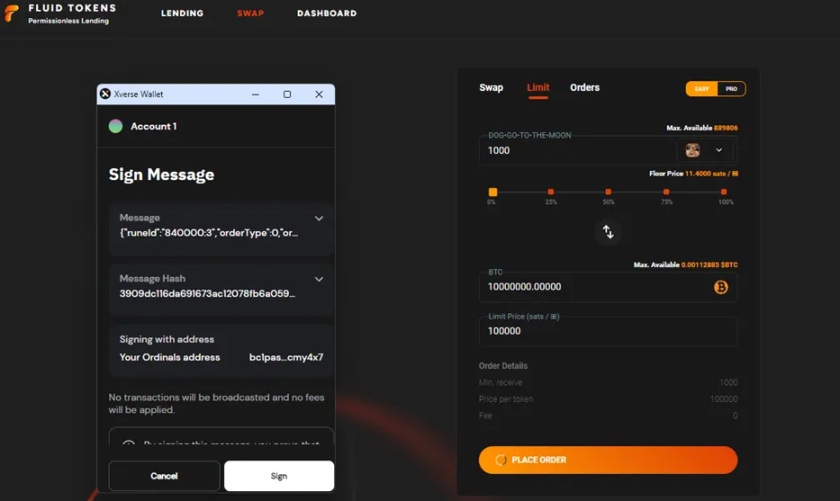
Website: https://btc.fluidtokens.com/swap
Twitter: https://x.com/FluidtokensXBT
Fluid Tokens is an order book-based decentralized exchange (DEX). Users can currently trade Runes-BTC, and the Runes-Runes feature is about to be launched. Fluid is essentially a peer-to-peer trading market. When a trader wants to create an order (maker), they make off-chain "commitments" (e.g., I want to sell 1000 $DOG and exchange for 0.001 BTC). These commitments are published as limit orders in the order book. When a buyer (taker) accepts the order, i.e., makes a market buy or sell, they initiate a PSBT (partially signed Bitcoin transaction) that details all the inputs and outputs committed by the maker. Then, the original maker is notified (via email or in-app) that their limit order has been matched, and they sign the PSBT to broadcast the transaction to complete the trade.
This trading design is completely permissionless and peer-to-peer. The market essentially facilitates these transactions. The trade-off is the back and forth in user experience. The maker makes a commitment, places a limit order - the taker matches the order and initiates a PSBT - then the maker signs and completes the PSBT. This friction essentially slows down the trading process and often cannot meet the demand for quick selling by traders. Another potential issue is order manipulation or deception, such as makers creating orders they have no intention of fulfilling to try to manipulate prices. To mitigate this, the Fluid platform currently only allows one maker commitment order per trading pair per address. Therefore, it is currently not possible to gradually build a position through staggered orders, but this feature is in the development plan.
All trades on Fluid are completely permissionless, and they are also protected from MEV and sniping by using "Sighash All" in PSBT, meaning that the transaction is only validated when both the maker and taker addresses are involved in the trade. Third parties cannot "snipe" the trade, which often happens in transactions on popular markets like Magic-Eden and Unisat. Fluid prioritizes completely permissionless and secure trading, at the cost of a less smooth trading experience. Fluid will launch their market in the coming weeks.
2. Saturn BTC
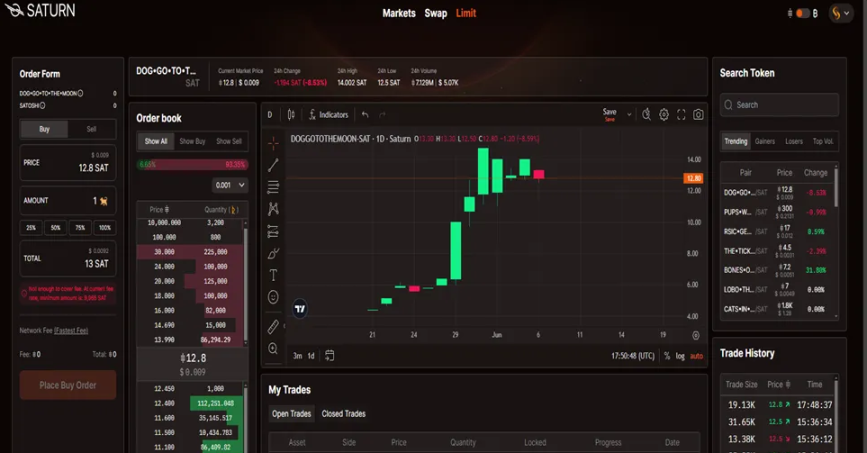
Website: https://www.saturnbtc.io/
Twitter: https://x.com/Saturn_btc
Saturn BTC is an order book-based on-chain trading platform, initially launched for rare sats (the smallest unit of Bitcoin) in the summer of 2023. They have just launched the Runes trading market. They focus on creating a smooth trading experience similar to centralized trading platforms. They have a "peer-to-peer" order book, where users can place limit orders on-chain to fill the order book, and users can also make market buys by "accepting" existing limit orders in the order book. This user experience is very smooth, especially as users do not need to worry about splitting UTXOs or exact requirements for matching orders placed by makers. This is a significant improvement over the traditional, more cumbersome Runes trading experience on Unisat and Magic Eden. Saturn also has an "exchange" feature, but this is not an AMM-style liquidity pool exchange. Through the exchange, users simply make market buys of the appropriate amount of sell orders in the order book, and vice versa.
To achieve this improvement in trading experience and functionality, especially related to limit orders and matching engines, Saturn currently requires users to "deposit" funds into a "trading account," which is a multi-signature account signed by the user and co-signed by Saturn. This "trading wallet" will be replaced by a one-time multi-signature in the next version. When users place limit orders, they sign a "Sighash None" PSBT, which technically transfers control of the specific tokens/bitcoins involved in that order to Saturn platform and the matching engine in a 2/2 multi-signature manner. The transaction is finally confirmed through "Sighash All" before being broadcast to the mempool, ensuring protection against sniping. This trading process means that as long as the order remains open, traders must trust Saturn to handle the specific funds involved. Therefore, the trading experience is not completely permissionless and has some centralized aspects.
Saturn has adopted an interesting and innovative approach by replicating the smooth trading experience of centralized exchanges directly on the Bitcoin Layer 1 chain. Their platform also offers full charting functionality provided by Trading View. Without the need to split orders, the platform handles these transactions, and there can be partial fills and multiple wallets within the same trade. Saturn is a very user-friendly, intuitive decentralized trading platform with many product improvements and new features in its roadmap.
3. UniTap
Website: https://unitap.io/
Twitter: https://x.com/Uni_Tap
Unitap is a decentralized exchange (Dex) built for the TAP ecosystem. The TAP meta-protocol enables various DeFi functions and operations to be directly conducted on the Bitcoin Layer 1, utilizing distributed indexers to assist with calculations and account balances.
Unitap is building a market not only for trading Tap-based assets but also for Tap to Runes trading. They are developing a bridging solution for Runes to Tap.
Unitap has designed a fully non-custodial exchange system. Users wishing to sell tokens (e.g., -tap) can create a PSBT using "Sighash Single," specifying the quantity of tokens they wish to sell and what form (token and quantity) they want in return. The return can be BTC or other Tap or Rune tokens. This creates a very specific sell order that may take some time to find a match, especially in low liquidity market conditions. To help overcome this friction, Unitap places this sell order into the market, matching it with all other orders from buyers that fit this specific sell order. For example, if I want to sell some $-tap, I can select the token and click the "Give" tab. This will open a market containing all orders to buy $-tap, where sellers of other assets are looking for $-tap in exchange for their assets (see the screenshot above). This increases market flexibility and helps facilitate quick sales that traders like. Currently, Tap-Tap assets are tradable, and Tap-Runes and Runes-Tap exchanges will be launched in the coming months.
Unitap will also be launching its own wallet in the coming weeks, supporting all TAP operations and enabling cross-protocol exchanges, such as Tap-Runes or Tap-BRC20.
4. Dotswap
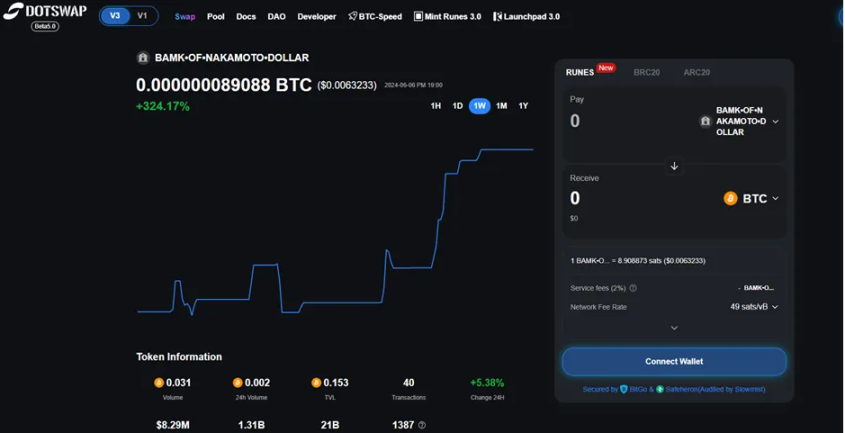
Website: https://www.dotswap.app/
Twitter: https://x.com/dot_swap
Dotswap is a native AMM-style trading platform on the Bitcoin Layer 1, supporting BRC20, ARC20, and Runes. Its trading experience is very similar to how Uniswap operates. Users can already exchange between BRC20/Bitcoin and Runes/Bitcoin, with Runes/Runes exchange coming soon.
Atomic swaps are completely non-custodial and permissionless, using "Sighash All" PSBT. Users select how much Bitcoin/token they want to exchange and receive the corresponding quantity of another token in the same transaction. Using Sighash-All means that all trades have resistance to sniping.
The liquidity pool here is custodial. When liquidity providers deposit funds into the liquidity pool, these funds are stored in a multi-signature system, as Bitcoin does not have smart contracts to send funds to. Dotswap's unique MMM (Multi-layer Multi-signature Matrix) custodial solution is internally developed and operated in collaboration with custodial partners Safeheron and BitGo. The process of adding and removing liquidity is as simple as expected, similar to the experience of EVM AMMs. Dotswap is the first team on Bitcoin to implement a centralized sequencer to protect trade ordering (and therefore price ordering).
Dotswap has also developed a new Runes token launch platform, operating similarly to pump.fun on Solana. Participants use Bitcoin to purchase specific Runes tokens at launch, with most of the Bitcoin used to seed the liquidity pool for that token. Therefore, any Rune launched on this platform has an immediately available liquidity pool, allowing users to exchange and trade in a completely non-custodial manner. Contributors to the launch platform also own a share in the liquidity pool and can earn trading fees.
Dotswap has developed a fully non-custodial and permissionless AMM trading platform for traders/exchangers to use. Liquidity providers are the ones making trust assumptions. So far, Dotswap's trading volume has exceeded $40 million. If Dotswap successfully attracts more liquidity into their pools (through favorable trading fees, liquidity mining, etc.), trading volume should increase.
5. Ordiswap
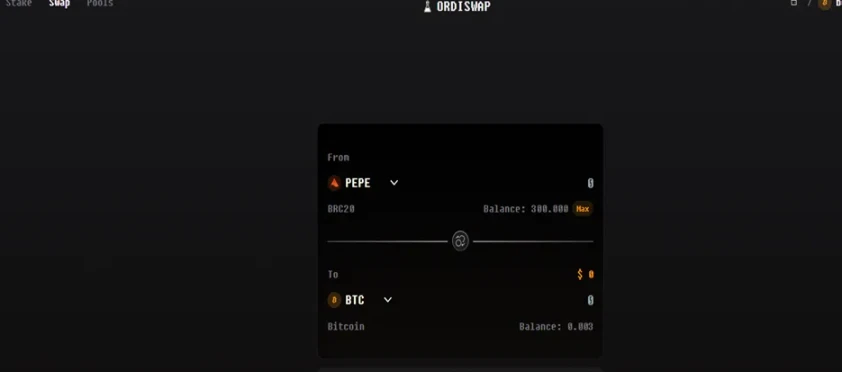
Website: https://app.ordiswap.fi/
Twitter: https://x.com/OrdiswapLabs
Ordiswap is an AMM for on-chain exchange of BRC20 or Runes tokens. Users can exchange, provide liquidity, remove liquidity, and create new liquidity pools on the Bitcoin Layer 1. Last year, Ordiswap was the first AMM to appear in the BRC20 space.
When a user initiates an exchange on Ordiswap (e.g., swapping BTC for ORDI), they create a transaction sending their BTC to Ordiswap liquidity providers. This transaction also includes a script containing the exchange details. The Ordiswap backend indexer reads this script and subsequently sends the corresponding quantity of ORDI to the user in a later transaction. This means that users must trust the Ordiswap API when signing the transaction to initiate the exchange.
Ordiswap uses a set of off-chain servers, oracles, indexers, and Bitcoin nodes to create AMM functionality. Ordiswap's servers update off-chain balances of participating users in transactions and perform periodic settlements on-chain. Currently, all exchanges are processed by the Ordiswap API. This solution is slightly less elegant than using PSBT for atomic swaps, which can complete the entire exchange in the same transaction. However, atomic swaps are on the roadmap.
The liquidity pool is once again custodial, and discussions with custodial partners about upgrading security are ongoing. Their V2 BRC20 exchange has been live for two months, with a total trading volume of approximately $500,000.
If they can achieve everything they have set out to do, Ordiswap also has the potential to become a major AMM on Bitcoin. This is an ambitious, modular Bitcoin exchange implementation. They are currently in the closed testing phase of V3 mainnet. It is reported that testing is progressing smoothly, and they are finalizing the last details of the exchange mechanism.
6. RunesDex
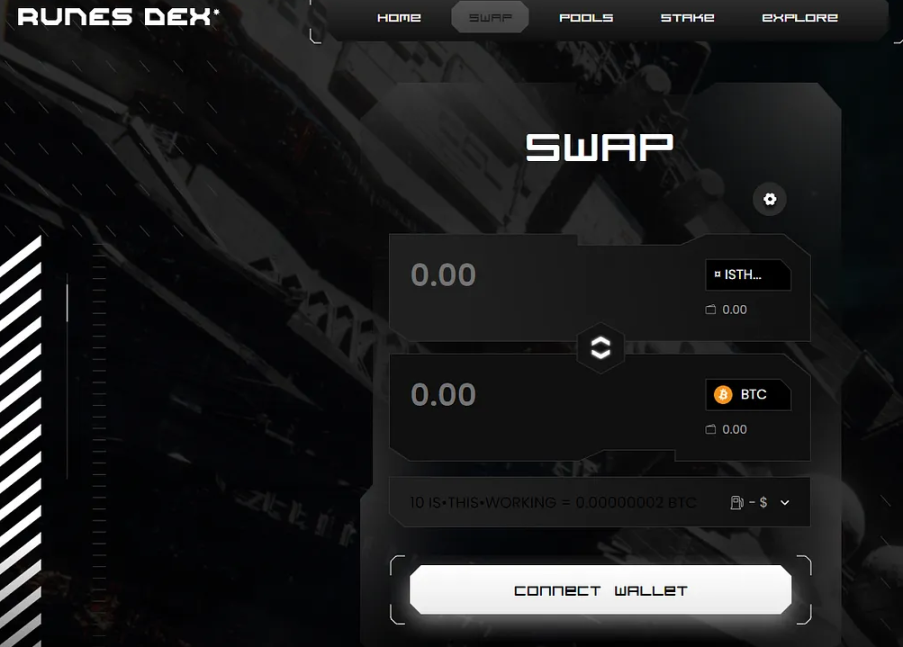
Website: https://www.runesdex.com/
Twitter: https://x.com/RUNES_DEX
Runes Dex is another recently launched AMM on Bitcoin Layer 1 for Runes-BTC trading. They are well-funded, have a large team, and are growing rapidly. They are currently in the alpha testing phase on the mainnet. Users can test exchanging their native Rune IS•THIS•WORKING. Similar to the aforementioned AMMs, trading on Runes Dex is completely non-custodial and permissionless, but the liquidity pool is custodial. Currently, Runes Dex has full control of the private keys, which are stored in a vault using AWS. Custodial partnerships are in the works.
They are also building a launch platform similar to pump.fun, a Runes tracker that takes into account pending transactions in the mempool, and a Runes bridger for bridging memecoins from other chains like Solana to Runes. They use "Sighash All" in Dex exchange PSBTs, meaning each exchange has resistance to sniping. They plan to charge liquidity providers in Bitcoin. They have also created an automatic UTXO splitter for liquidity providers to ensure a smooth experience during exchanges. Runes Dex's AMM will be fully launched in the coming weeks. Another promising AMM.
7. Runeswap — Swapsats
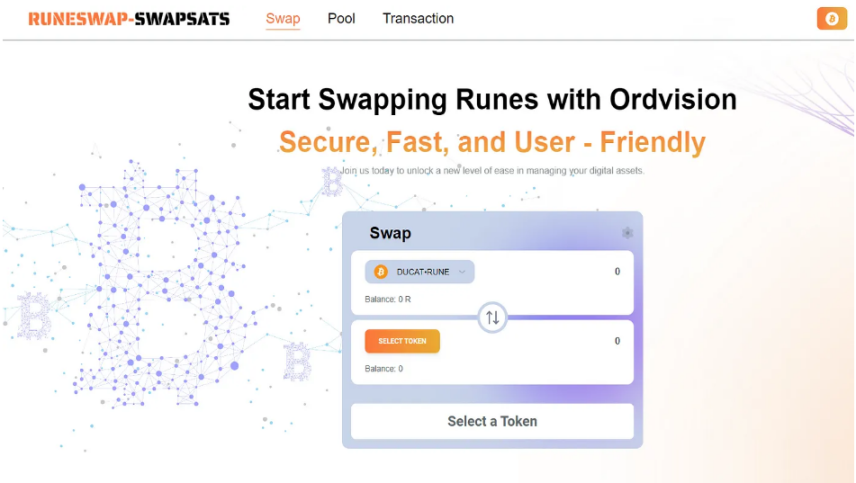
Website: https://rune-testnet.swapsats.io/
Twitter: https://x.com/Swapsats_io
Runeswap, developed by the Swapsats team, is an AMM-style exchange platform for Runes-BTC, with the team behind the OG sub 10k Ordinals collection Ordinal Eggs. This exchange platform will operate similarly to the exchanges mentioned above; providing a permissionless exchange experience, but the liquidity pool is custodial.
As a group of collectors, their philosophy is to create a decentralized trading platform for their community. Holders of their collectibles will receive various benefits on the trading platform, such as reduced trading fees and a share of the revenue from the trading platform. They prioritize a smooth user interface and a good user experience to further nurture their community. Currently, the exchange platform is in the alpha testnet phase, with plans to launch on the mainnet in the coming weeks.
8. RunesFi
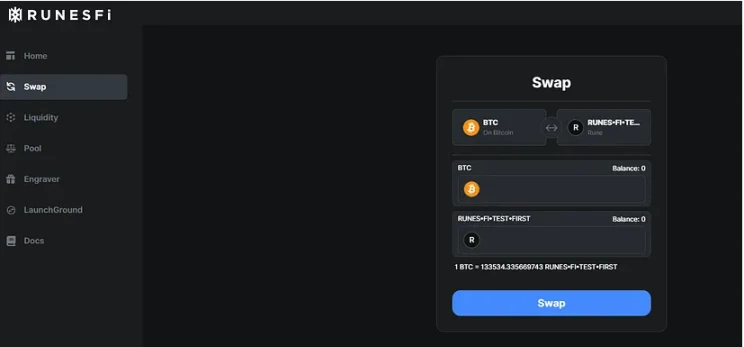
Website: https://runesfi.io/
Twitter: https://x.com/Runes_Fi
RunesFi aims to become a one-stop infrastructure center for Bitcoin assets. They plan to build a Runes block explorer, launch platform and incubator, Runes carver, and most importantly, a decentralized trading platform for Runes and BRC20. They are currently in the testing phase of their trading platform, with their mainnet product expected to launch by the end of 2024.
There are several other decentralized exchange platforms in development promising more decentralization than those listed above, such as Omnisats and Motoswap (OPNet). I can analyze them when they are close to launch and more information is available. Unisat recently announced their new BRC20 exchange module, which will include liquidity pools, etc. It is currently in development and expected to be available within 6 months. Magic Eden is also hinting at an upcoming exchange feature, although the timeline is not clear.
9. Conclusion and Outlook
Building on Bitcoin is challenging, especially if trying to directly replicate the functionality of the Ethereum Virtual Machine (EVM). Teams that can fully leverage Bitcoin's unique mechanisms (such as PSBTs, Sighashes, etc.) are more likely to succeed in the long run than teams simply trying to recreate the EVM stack.
Teams creating innovative solutions are making trade-offs in different aspects. For example, in the decentralized order book exchange platform, Saturn prioritizes an ultra-smooth user experience and functionality, sacrificing fully permissionless trading. Fluid takes a different approach, prioritizing completely decentralized and non-custodial trading, although with some friction in the trading experience. It will be very interesting to see which philosophy the market values more.
In the Automated Market Maker (AMM) space, most teams are creating a system that allows traders to trade completely permissionlessly, but the liquidity pool uses some form of vault, multisig, or semi-custodial solution. This may be an acceptable compromise, as most traders do not care about the setup of the liquidity pool as long as they can exchange quickly and permissionlessly. Additionally, considering how many bridges and contracts have been attacked on Ethereum, providing liquidity to reputable custodians may even be a more attractive solution. Currently, Dotswap has an advantage in this regard, as they have gone the furthest in development, product offering, and liquidity provider custodial solutions. However, other teams like RunesDex and Ordiswap are also close behind, with their products about to be launched.
I believe there are other teams building that I am not aware of at the time of writing.
免责声明:本文章仅代表作者个人观点,不代表本平台的立场和观点。本文章仅供信息分享,不构成对任何人的任何投资建议。用户与作者之间的任何争议,与本平台无关。如网页中刊载的文章或图片涉及侵权,请提供相关的权利证明和身份证明发送邮件到support@aicoin.com,本平台相关工作人员将会进行核查。
